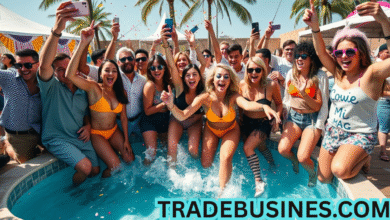Understanding the Concept of “Influencers Gonewild”
The phrase “Influemcers Gonewild” represents a growing trend in the world of social media where digital personalities engage in behavior that pushes boundaries, often leading to public controversy or a redefinition of what it means to be an influencer. This phrase encapsulates more than a simple scandal. It reflects a cultural shift where online fame comes with fewer rules, more exposure, and an increasingly blurred line between personal expression and public spectacle.
In the modern digital age, influencers are powerful figures. They shape opinions, create trends, and even influence political and social movements. However, when fame meets unfiltered access to millions of followers, the results can sometimes spiral into dramatic territory. Influencers stepping outside expected norms or engaging in wild, controversial, or provocative behavior is no longer rare—it’s often expected, watched, and monetized.
The Pressure of Constant Visibility
One of the core reasons behind this phenomenon is the relentless pressure Influemcers Gonewild face to remain relevant. Social media platforms reward constant engagement, fresh content, and viral moments. This need for ongoing attention can push individuals to extremes. What begins as a fun prank, a bold fashion statement, or a cheeky post can quickly escalate into a spectacle that attracts both admiration and backlash.
Many influencers live under a microscope, where every post, story, or video is scrutinized by fans, critics, brands, and media outlets. The pressure to be edgy, relatable, or unique can lead them to make impulsive decisions. In a bid to stand out in a saturated market, some turn to shock value, sometimes resulting in a “gone wild” image that dominates headlines for all the wrong reasons.
Social Media Algorithms and Incentives
Behind every viral post or trending scandal is a powerful algorithm. Platforms like Instagram, TikTok, YouTube, and Twitter reward content that receives high engagement, whether it’s likes, shares, or comments. This means that sensational content—especially that which generates strong emotional reactions—is more likely to be promoted.
This system unintentionally incentivizes controversial behavior. An influencer posting something wild, emotional, or outlandish may gain hundreds of thousands of new followers overnight. The more outrageous the content, the more attention it garners, leading to increased monetization opportunities, sponsorships, and media coverage.
As a result, influencers may deliberately craft personas that teeter on the edge of acceptability. Their “gone wild” image is not always accidental. It is often calculated, risky, and carefully monitored to maximize exposure while attempting to avoid permanent brand damage.
Impact on Personal and Professional Lives
When influencers cross lines or engage in controversial antics, the fallout can be significant. Reputations can be destroyed overnight. Brands may sever ties, followers might abandon ship, and mainstream media could weaponize their behavior for clicks. This impact extends beyond the screen.
For many, the emotional and psychological toll is immense. The backlash from an online controversy can lead to stress, anxiety, and even clinical depression. Some influencers face doxing, harassment, and threats. Others struggle to rebuild their public image and trust with their audience.
On the flip side, not all influencers face negative consequences. Some successfully capitalize on the attention, turning the controversy into business ventures or rebranding opportunities. In certain cases, the “gone wild” phase becomes a stepping stone to new careers in entertainment, fashion, or adult content industries.
Blurring the Line Between Public and Private Life
Another element of this phenomenon is the erosion of privacy. Influencers often broadcast their daily lives, relationships, and personal moments for public consumption. This exposure builds intimacy with followers but also leaves little room for error. The boundary between public and private life is nearly nonexistent, and fans expect constant updates, vulnerability, and access.
When influencers behave wildly—whether through partying, explicit content, feuds, or personal breakdowns—it’s often captured in real time. Followers don’t just observe these moments; they participate by commenting, reposting, and spreading the content across platforms. The influencer’s personal life becomes entertainment, and the public feels entitled to judge and engage.
In many cases, the influencer themselves may not intend to “go wild,” but the amplification by viewers turns an ordinary moment into viral chaos. A slip of the tongue, an emotional rant, or a misunderstood post can become a full-blown spectacle overnight.
Cultural and Generational Shifts
The rise of “Influencers Gonewild” also reflects broader cultural shifts. Younger generations are more accepting of bold, unfiltered self-expression. The taboos of previous decades are fading, replaced by a celebration of authenticity—even if it’s messy, raw, or scandalous.
This environment creates fertile ground for wild behavior to flourish. Nudity, profanity, mental health breakdowns, political rants, and wild parties are no longer just private matters—they are forms of content. And in the world of influencers, content is currency.
For some, this is empowering. It allows for liberation from rigid norms and offers a platform to share real, unfiltered experiences. For others, it’s dangerous, as the need for constant engagement may push individuals beyond their emotional limits. The cultural tolerance for wildness has grown, but so too has the mental and social cost.
The Business of Controversy
Influencers often turn controversy into capital. OnlyFans, Patreon, and other subscription platforms have enabled many influencers to monetize provocative content directly. The “gone wild” brand becomes a deliberate strategy, with content tailored to cater to audiences who crave boldness and rebellion.
This shift also means that influencers no longer rely solely on traditional brand deals. They can monetize their personas through exclusive content, merchandise, and even appearances. A single scandalous video or photo can become a marketing opportunity if managed strategically.
However, this business model comes with risks. Once an influencer builds a reputation based on controversy, it becomes difficult to pivot to more mainstream or respectable avenues. Their audience may only engage with the wild content, creating a brand trap that limits long-term growth and credibility.
Societal Reactions and Moral Panic
The rise of influencers behaving wildly often triggers moral panic, especially among older generations or conservative communities. Critics argue that such behavior sets a bad example, corrupts youth, and damages the integrity of online platforms.
While some criticisms are valid, others reflect a generational misunderstanding of internet culture. What seems shocking to one demographic may be seen as normal or even admirable to another. Wild behavior is often reinterpreted as rebellion, authenticity, or bold self-expression rather than recklessness.
The tension between evolving digital norms and traditional values continues to fuel debates around influencer conduct. As society adapts to the changing landscape of fame, conversations around ethics, responsibility, and freedom of expression remain central.
Consequences for Followers and Young Audiences
Perhaps the most overlooked aspect of the “Influencers Gonewild” trend is its effect on followers, particularly impressionable young audiences. Influencers wield tremendous power, and their behavior can influence attitudes, fashion, body image, and lifestyle choices.
When wild behavior is glorified or normalized, it can lead to unrealistic expectations about life, success, and behavior. Young fans may mimic risky behavior in hopes of gaining attention or popularity. The pursuit of virality, fame, and validation becomes a dangerous game, especially when filtered through the lens of wild influencer culture.
Parents, educators, and mental health experts have expressed concerns about the impact of such content on youth. The challenge lies in educating users about responsible content consumption while encouraging platforms to enforce community guidelines without stifling free expression.
Regulating the Wild: Platform Policies and Ethics
Social media platforms have attempted to curb controversial behavior through content moderation, bans, and demonetization. However, enforcement is inconsistent. Influencers with large followings or verified status are sometimes given more leeway than average users. This selective moderation fuels further controversy.
Ethically, platforms face a dilemma. They profit from viral content, including controversial moments, but also bear responsibility for the environment they create. Striking a balance between profitability and accountability remains an ongoing challenge.
At the same time, influencers must also practice self-regulation. Understanding the long-term implications of their actions, maintaining a balance between entertainment and responsibility, and considering the influence they wield is crucial to preserving integrity in the digital space.
The Future of Influencers in a Wild World
As influencer culture evolves, so too will the definition of acceptable behavior. Today’s wild antics may become tomorrow’s norms—or fade into obscurity as audiences grow tired of sensationalism. New platforms, technologies, and audiences will reshape how influencers express themselves and engage with the public.
The future may bring a rise in more authentic, grounded influencers who balance bold content with emotional intelligence and responsibility. Alternatively, we may see an escalation in digital wildness as new forms of immersive content like VR and AI blur the lines between real and performative even further.
Ultimately, influencers remain a reflection of the society that supports them. Their wildness is not isolated—it’s a mirror of our collective digital desires, values, and curiosities.
FAQs About Influencers Gonewild
What does “Influencers Gonewild” mean?
It refers to situations where social media influencers engage in behavior that is extreme, controversial, or sensational, often resulting in viral attention or backlash.
Why do influencers act out or behave wildly online?
They often do so to gain attention, stand out in a saturated market, or respond to the pressure of staying relevant. Some may also act out unintentionally due to emotional strain or public scrutiny.
Is this behavior harmful to followers?
Yes, especially for younger audiences. It can lead to unrealistic expectations, mental health issues, or the imitation of risky behavior.
Are there any benefits for influencers who go wild?
In some cases, controversy leads to Influemcers Gonewild increased visibility, brand deals, or monetization opportunities. However, it often comes at the cost of reputation and long-term trust.
Can platforms prevent this type of content?
Platforms try through moderation and policies, but enforcement is inconsistent. Influencers themselves must also take responsibility for their actions and content.



